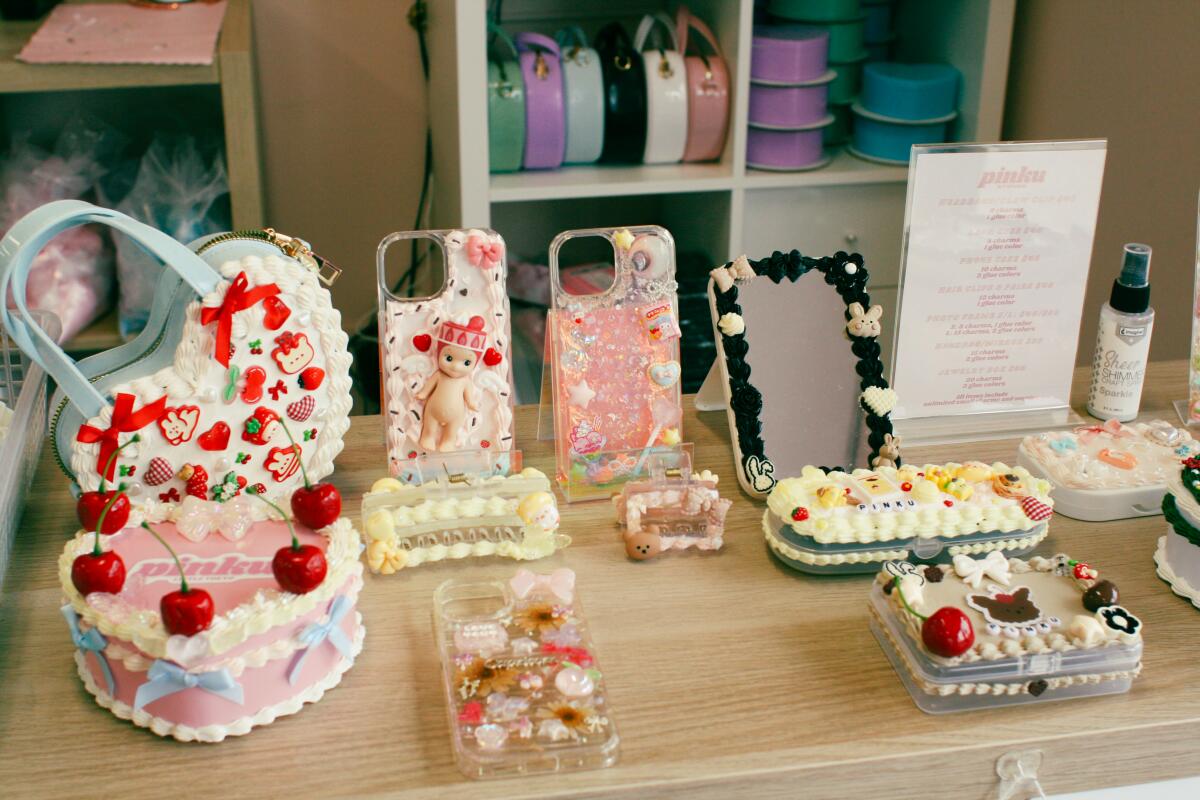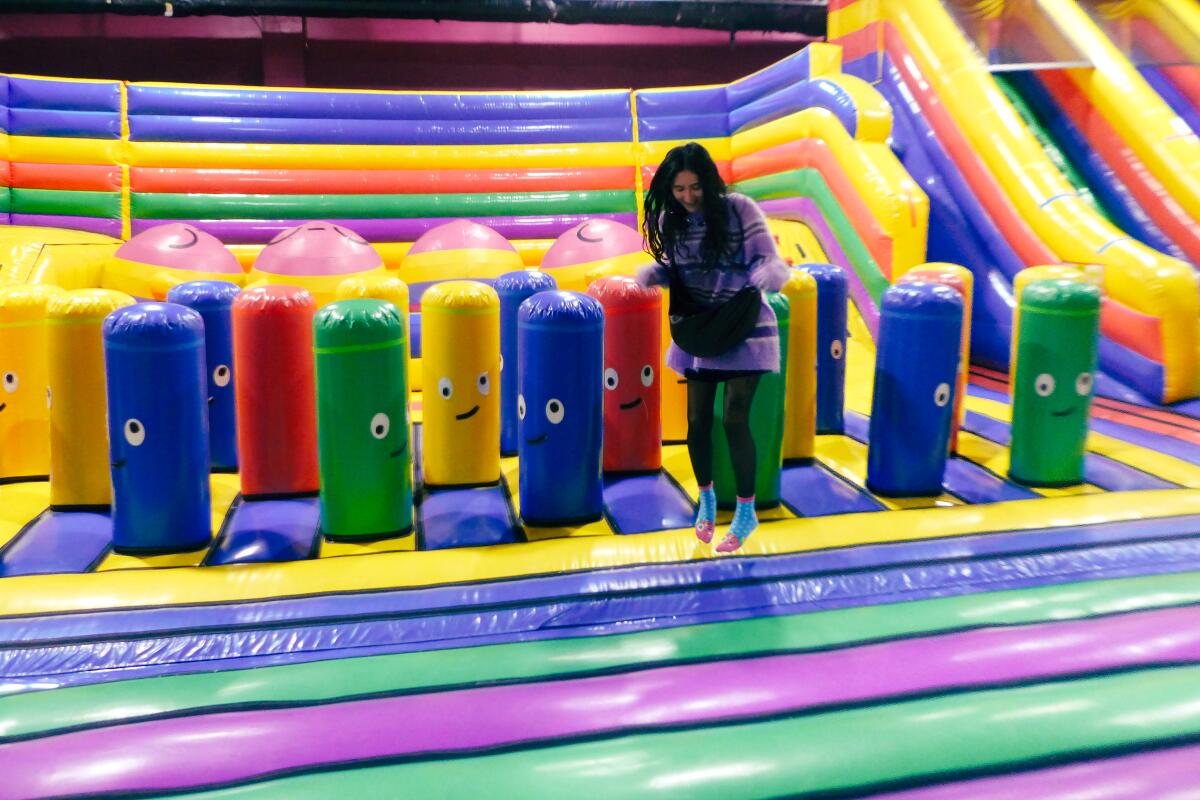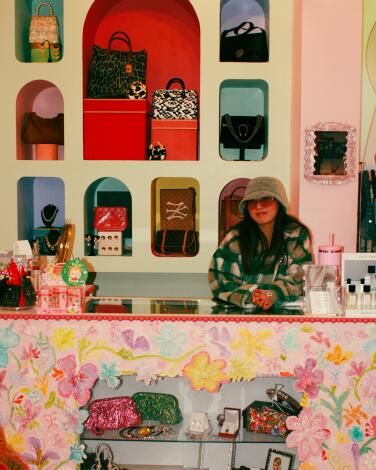
More than just cute, kawaii is a lifestyle. Embrace it at these 11 adorable spots in L.A.
- Share via
You can trace the word “kawaii” all the way back to the start of the 11th century, when an early form of it, “kawayushi,” which at the time translated more to “having pitiable qualities,” appeared in the Japanese novel “The Tale of Genji” by Lady Murasaki.
Cuteness as a Japanese concept predates the modern use of the word “kawaii” — for example, in Japan’s Edo period (1603-1868), netsuke, or miniature charms made of ivory or boxwood, were all the rage. Citizens would style their outfits with them, much the way phone charms are used today. As the word contracted into “kawaii” in the early 20th century, the meaning changed to literally translate to “face aglow” or “blushing” and began to take on its adorable connotation.
Ultra-cute as a lifestyle exploded throughout Japan in the 1950s and ’60s with artist Rune Naito, whose illustrations (and later, netsuke-style ceramics) of adorable girls and big-eyed animals are considered the origin of contemporary kawaii culture. (Naito also was an early queer icon in Japan for providing illustrations to gay magazines.) The queen of kawaii, Hello Kitty — canonically a girl in a catsuit — was created by Sanrio’s Yuko Shimizu in 1974.
Fast forward to the ’90s, when anime like “Dragon Ball Z” and “Pokemon” began to filter to the West and a new era of Japanophilia was born. (By the time Westerners adopted the cute life, Japan had a wealth of kawaii animal characters to offer.) “UwU” — the emoticon pronounced “oo-woo,” representing a smitten face that would light up a million AOL Messenger chats — soon followed.
Planning your weekend?
Stay up to date on the best things to do, see and eat in L.A.
While the word translates from Japanese to “cute,” that doesn’t quite express how saccharine-sweet kawaii can be. Think pastel pinks and purples, Victorian frilly outfits, giant anime eyes — it’s a state of pure cuteness, toeing the line of aesthetic taste.
And yet kawaii has persisted, morphed and evolved. Nowadays, cute things are everywhere, perhaps an artifact of the times we live in and the alleged infantilization of millennials. Los Angeles is no stranger to the variants of kawaii, from bounce castle parks and maid cafes to photo studios with adorable props and claw machines that spit out stuffed animals to lucky kids — and adult kids. Here are a few places to get your fix.
Gudetama Cafe

Egg-icide aside, the cafe is a kawaii destination, attracting Sanrio fans from all over the world, as well as fans who identify with the egg’s “meh” catchphrase. The cafe features large statues of Gudetama in various states of listlessness. The tables are yellow and feature his egg face too.
FYI: The dishes are eggs-cellent — I had the A(meh)zing Double Egg and Cheese, which comes on a crisp brioche bun. But even better is the Sparkling Mango, with its little boba balls of yellow mango at the bottom meant to look like egg.
UwU factor: 3/5
Asayoru Maid Cafe

The concept of a maid cafe is quintessentially Japanese, born from cosplay culture and thriving as a niche of companionship and entertainment.
Before entering the cafe, you’re instructed on the magic words, “Moe moe kyun.” The phrase doesn’t translate (“moe” is slang for “cute,” and “kyun” is onomatopoeia for a feeling of getting choked up), but it acts as a blessing — you have to say it before you walk in the “magic door” into the cafe, and you will be prompted to say it over all the food or drinks you consume over the evening.
You are greeted upon entering by a chorus of “Okaerinasaimase, goshujin-sama ojou-sama” (Welcome home, master/mistress) from the maids lined up to greet you. From there, you are waited on by the maids in their exaggerated French maid outfits. You can order dinner — the specialty is omurice, a rice omelet that is a staple of Japanese home cooking — and nonalcoholic drinks like a magic color-changing lemonade.
“Chekis” are really the main event — for $10, a maid of your choice will pose in a mini-Polaroid photo. Then the maid will decorate the photo with cute lettering and drawings and return it to you before the end of the evening.
Asayoru co-founder and Head Maid Sae says that attending an evening at a maid cafe is akin to a night at Medieval Times but with a distinctly kawaii twist. The world-building “sets the experience apart, and it’s why so many people come back,” she explains, showing me several books of cheki collections that her regular customers had brought in that evening. One collection from a truly devoted follower contained dozens, if not hundreds, of photos taken with Asayoru maids.
FYI: What really sets Asayoru apart is the option to request a choreographed J-pop dance performance. For a fee, your chosen maid will perform a specialty routine, often featuring hits from groups like the popular AKB48, for the whole cafe.
UwU meter: 5/5
Pinku D.I.Y. Design Studio

You tell Murayama your phone model and she provides you with a clear, blank phone case. Then, you pick two colors of glue — I chose pastel pink and lavender — and 10 selections from a table full of cute charms. Your options run from cherubic angels and flowers to Disney and Sanrio characters. Murayama sets you up at a workstation and gives you a quick tutorial on how to squeeze the glue from the provided frosting piping bag. The goal is to make your phone case look like cake. Then you press the charms into the glue, let the case dry for five days at home, and voila, you have an official “decoden” case. (The whole experience, including the case and charms, costs $45.)
The term “decoden,” which originated in Japan around the time of flip-phone proliferation in the early 2000s, is a portmanteau of “decorated” and “denwa,” the Japanese word for phone. The latter-day version, which mostly takes place on the cases that house your iPhone or Android, has gained popularity on TikTok due to its aesthetic appeal.
Murayama says people even come into Pinku in gothic Lolita dress — a maximalist Japanese street fashion symbolized by bell-shaped Victorian skirts and bold makeup. “That just makes my day,” she says.
FYI: Pinku isn’t limited to phone cases — those are just the most popular item. You can also decorate jewelry boxes, hairclips, handbags and mirrors. Bring your own item and get $2 off.
UwU factor: 4/5
Pink Moon Atelier

In March 2022, Estantino opened Pink Moon Atelier, a boutique with kawaii accessories and collectibles. Not for sale is Estantino’s collection of kawaii-themed kicks (“I’m a sneakerhead,” she says) displayed inside glass cases.
Many of Pink Moon Atelier’s items that are for sale come from small, woman-owned businesses. There are stickers and keychains by Sherman Oaks gamer shop GeekyGlamorous, pins and stickers by illustrator Alisa Draws and sweatshirts and bags by designer LoveAprilMoon. The clothing on the racks is size-inclusive, “because kawaii is for everyone,” says Estantino.
The shop plays host to group art shows, pop-ups and workshops, making Pink Moon Atelier a kawaii community center.
UwU factor: 4/5
Funbox

With an inflatable surface decked in bright, cheerful colors and a cast of adorable characters with names like Drippy, Stix, the Gumdrops and Cosmo (the leader) who wear the sort of adorably warm grin that would make a Sanrio character blush, Funbox has several zones of fun, from Marshmallow Mountain to a harrowing obstacle course.
When you arrive, you’re instructed to put on cute grippy socks (even they have faces) and place your valuables in a locker (lest they fly out of your pockets during a particularly uncontrolled bounce). Once you’re untethered to your objects, you can bounce on anything — the whole place is covered in inflatable bouncy canvas, so it’s not only cute but also safe for everyone to go as berserk as the Tasmanian Devil.
The true cuteness of Funbox is in the energy. Kids and adults alike bounce, slide down slides and giggle as they tumble around in joyful chaos. The colorful, wobbly structure comes alive. Tickets are $22 for ages 6 and over, $12 for ages 3 to 5 and $59 for a family four-pack, which includes any age. Toddlers up to 2 are free.
UwU factor: 3/5
Monkey Pants

Monkey Pants’ newest obsession is Fueki, a Japanese company founded in 1886 best known for its cornstarch-based paste that comes in an adorable yellow doll’s head. That yellow character — which is reportedly a dog — now has a few friends, a blue elephant and a pink bunny. Fueki is a bit mysterious, a bit inscrutable and a whole lot kawaii. Hardy has imported a trove of products and stickers; Fueki now inhabits a whole wall at Monkey Pants.
“I’ve been addicted to all things cute since I could breathe,” says Hardy, whose favorite toy was a Monchhichi when she was a kid. “So I made a store about that.”
FYI: Monkey Pants is located in Little Tokyo, where there is a cluster of stores selling cute objects — there’s an official Sanrio store around the corner, and an official Gashapon Bandai store with more than 200 “gasha” machines (coin-operated toy dispensers).
UwU factor: 4/5
Crumbs & Whiskers Cat Cafe

Crumbs & Whiskers, which opened in 2016, takes the idea a step further. You can go into this cat cafe on Melrose and relax, destress, have some coffee and enjoy feline companionship, but you also can go home with one (or more!) of the location’s current roster of 25 kitties, which have been saved from euthanasia. The cafe works with Kitten Rescue Los Angeles to populate the kitty zone.
Spending time at Crumbs & Whiskers isn’t cheap — on the weekends, it’ll run you $28 for 30 minutes or $45 for 70 minutes (weekdays are a little cheaper) — but the cafe also takes care of the kitties and provides them with medical treatment, so it feels a little like a donation. (Advance online bookings for cat time are recommended.)
At the cat cafe, interactivity is key. A black cat named Bandit might stalk you around the cafe and attack your pant leg. A tuxedo cat named Squeak might make biscuits on a nearby couch. Or a calico named Gwendolyn might look at you with big kitty eyes next to a sign that says “Saved from euthanasia: 4,795.” The adoption fee is $150 per cat (or $250 for two).
UwU factor: 4/5
NeoFuns Arcade

In the 1980s, claw machines became ubiquitous simultaneously in the United States and Japan, due to the rise of video game arcades here and the release of the ultra-popular Sega claw machine in Japan. They even had a cultural moment after the film “Toy Story” featured one filled with green squeeze-toy aliens that became fan favorites. (In fact, claw machines are known as “UFO catchers” in Japan due to the resemblance of the claw to UFO depictions.)
NeoFuns Arcade in Monterey Park is a version of the latest iteration of claw-machine culture — a whole arcade filled not with video games but with the skill-based machines. NeoFuns’ machines hold the most kawaii of plushies — think Stitch from “Lilo & Stitch,” Hello Kitty holding a heart and Hello Kitty’s dog friend Pompompurin.
HYou get a card loaded with credits, which you buy a la carte at $1 for six credits. (Each machine requires four to 12 credits based on the size of the plushie you’re clawing at.) But the best deal is to get one of the packages, starting at $25 for 186 credits, which guarantees you a plushie from a selection at the counter — you’ll likely score at least one or two at the machines as well.
FYI: I received a tip from another patron that the move is to angle the claw over the heaviest part of the plushie. This strategy is confirmed to work.
UwU factor: 2/5
Tsun Scoops

Remember Neopets? Well, the virtual-pet site popular in the early 2000s is still around, and it is just as cute as ever. Tsun Scoops, which specializes in kawaii collabs on its creamy creations, has created flavors like Kacheek’s Grove Twist (kiwi and lemon custard) in honor of the tiny green Neopet and Aisha’s Blueberry Bash after the psychic Neopet. A Neopets vlog plays on the TV next to the freezer.
Their regular flavors include uwube and Doki DoKey Lime Pie (“doki doki” is Japanese for the beating of the heart when, say, a crush is nearby), in case you needed more evidence of Tsun Scoops’ ability to melt your heart.
FYI: Tsun Scoops even has a ramune-flavored ice cream, which tastes like a popular Japanese lemon-lime bottled drink.
UwU factor: 3/5
Carousel's

Their shop is filled with treasures, from pastel stationery and Sanrio ephemera to streetwear and soft-goth home decor. “It’s all fun and nostalgic,” says Pearl Kim, who grew up on Sanrio and says that the store reflects her love for design and cuteness — but it’s cute with a bit of a cool-girl edge.
The look of the store is a wonder unto themselves; the Kims tapped superstar interior designer Dani Klariç to add elements like a hand-textured checkout counter and cathedral-esque walls.
FYI: Carousel’s has classics like four-color pens topped with Sanrio fave Cinnamoroll, along with unique items like a deadstock Hello Kitty CD case for your car’s sun visor.
UwU factor: 3/5
Life4Cuts Flagship Studio

The Buena Park location is a major attraction at the Source O.C. mall. There are a few other locations in SoCal (though the Hollywood location is closing for good soon), including studios in Arcadia, Rowland Heights and Stanton. But Buena Park is the flagship, and while you don’t need reservations, bring some patience, as the four studios fill up quickly and you may need to wait in line. Even weekdays can be busy.
To maximize the kawaii features of your visit, first check yourself in the large mirrors in the lobby area. Select from a number of plushie hats and plushie characters from BT21, a collab between K-pop group BTS and Line Friends (Line is a phone messaging app popular in Japan and South Korea), including Koya, a koala; Chimmy, a dog in a yellow hoodie; and Tata, who has a hyper-elastic body and a heart for a face. Head into the studio and choose your background from a rotating number of K-pop artists like Zico (who will show up around the borders of your pics) or collaborations like a kawaii anime version of Disney’s “Toy Story.”
You get two strips of photos for $10. Many people purposefully leave behind one of the strips, which then gets subsumed into Life4Cuts’ Hall of Fame on the walls outside the studio.
FYI: Life4Cuts is pet-friendly, so bring your pet in for a photo that will be literally too cute.
UwU factor: 3/5



